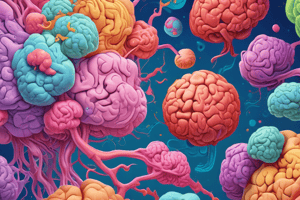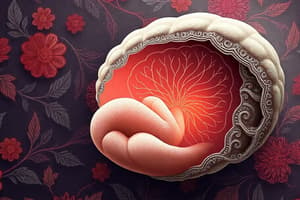Podcast
Questions and Answers
At what week does fetal brain development begin?
At what week does fetal brain development begin?
- 3rd week (correct)
- 1st week
- 5th week
- 9th week
Which factor is known to potentially reduce brain size in fetuses?
Which factor is known to potentially reduce brain size in fetuses?
- Mother's diet
- Father's behavior
- Maternal smoking (correct)
- Maternal stress
What is the term for the 'explosion' of neural connections that occurs in the first year of life?
What is the term for the 'explosion' of neural connections that occurs in the first year of life?
- Synaptic big bang (correct)
- Synaptic pruning
- Neural fireworks
- Neural expansion
Which of the following best describes the concept of epigenetics?
Which of the following best describes the concept of epigenetics?
What is a significant outcome of early experiences on child development?
What is a significant outcome of early experiences on child development?
How do genes contribute to brain development during infancy?
How do genes contribute to brain development during infancy?
Which factor does not play a role in infant growth and development?
Which factor does not play a role in infant growth and development?
What is one characteristic of the brain during early formation?
What is one characteristic of the brain during early formation?
What is the primary focus of infants' hearing development shortly after birth?
What is the primary focus of infants' hearing development shortly after birth?
During which stage of language production do infants begin to produce vowels only?
During which stage of language production do infants begin to produce vowels only?
At what age can infants typically begin to perceive depth using the visual cliff setup?
At what age can infants typically begin to perceive depth using the visual cliff setup?
What is one critical aspect of attachment theory related to caregiver interactions?
What is one critical aspect of attachment theory related to caregiver interactions?
Secure attachment in infants is primarily facilitated through which of the following?
Secure attachment in infants is primarily facilitated through which of the following?
During which stage of language development do infants begin to introduce consonant sounds?
During which stage of language development do infants begin to introduce consonant sounds?
What occurs during 'rupture' in the context of caregiver-child interactions?
What occurs during 'rupture' in the context of caregiver-child interactions?
Which type of attachment is characterized by a caregiver's inconsistent responses to their child's needs?
Which type of attachment is characterized by a caregiver's inconsistent responses to their child's needs?
At what age do infants typically startle at loud sounds as a response?
At what age do infants typically startle at loud sounds as a response?
Which daily occupation allows infants to build connections with caregivers while providing essential nutrition?
Which daily occupation allows infants to build connections with caregivers while providing essential nutrition?
Flashcards are hidden until you start studying
Study Notes
Prenatal Brain Development
- Foetal brain begins to develop in the third week of gestation
- Neuralprogenatal cells begin to divide and differentiate
- Neuralprogenatal cells form basis of nervous system
- 9th week brain is smooth and small
- Changes in brain reflect a cellular level
- Neurons at brain level start chemically signaling molecules
- This enables communication between nerve cells
- Children can be affected by parents behavior and environmental factors before birth
Epigenetics
- How environments influences and child experience effect the expression of their genes
- The DNA that makes up our genes accumulates chemical marks determine how much or how little of the gene are expressed
- Chemical marks = known as the epigenome
- Different child experience will change the chemical marks
Early Development of Senses
- Newborns have a good sensory system
- Respond positively to touch
- Can differentiate sensory input
- Respond when their body is moved
- Hearing is good even before birth
- Built in with reflexes
Vision
- Rapid development over first 6 months, primary interest in human faces
- Skilled muscle control and mental function
- Although infants can see, they are not ready to process this information
- First few years are more sensitive
- If this ability is not stimulate it will be lost
- A baby will learn how to process information into images
- Babies can see colour from birth but less vividly
- 2-4 months color desaturation improves
Hearing
- Foetuses begin to hear in the womb
- Preference for human voice
- Can distinguish between similar sounds by one month
- Can impact how they communicate
- Show a preference for mothers voice
- By 4 months they should startle when loud sounds
Language Production Stages
- Cooing: 2 months - produce vowel sounds only: "ooo and aah"
- Syllables: 3-4 months – consonant sounds being to be introduced, coordinate vowel and consonant sounds such as "Ga and Doh"
- Reduplicative babbling: 6 months - Syllables previously developed being to be produced repetitively "babababababa and omomomom"
- Conversational babbling: 10 months - syllables will be mixed into conversational tone with turn talking “Gadaba bomomo, ha!”
Infant Learning
- Hard to get information as you cannot do an interview with an infant
- Data is often found through inferring sensory capacity
- Visal cliff set up shows that from about 6 months infants can perceive depth
- Younger infants are likely to perceive the danger but still crawl over anyway however older infants are less likely to take this risk
- Proves that the fear of heights is learnt
Attachment Theory
- Bond with caregiver helps them build an understanding of themselves
- Helps them how to function in relationships
- Human biology says all infants will become attached to at least 1 caregiver
- However, quality of attachment will differ depending on factors
- First years of a child's life is the most important for forming secure attachment
- 3 types of children exist: secure, anxious resistant, anxious-avoidant
Facilitating Healthy Attachment
- Intersubjectively and attunement
- Rupture and repair
Intersubjectivity and Attunement
- Positive interactions between child and caregiver
- Whenever baby and caregiver are looking into each other’s eyes and sharing enjoyment
Attunement
- Where baby mirrors caregiver
- Mirror each other (mainly facial expressions)
- Helps baby to understand and regulate their emotions + creates secure attachment
Rupture and Repair
- Experience of child being out of sync or mistuned with caregiver can produce a 'rupture' in the relationship
- Rupture = negative child-caregiver interaction, could be initiated by child or caregiver
- 'Repair' relates to the caregiver and child reconnecting and re-engaging in an attuned way after a relationship rupture.
Studying That Suits You
Use AI to generate personalized quizzes and flashcards to suit your learning preferences.




